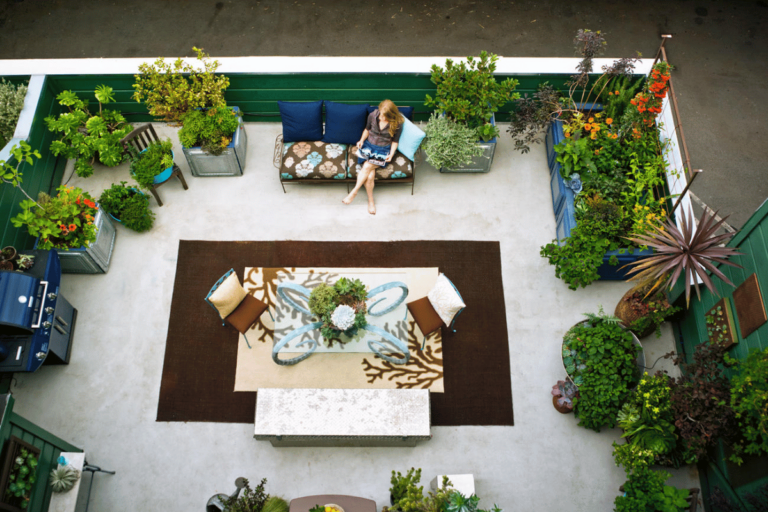Maximizing Small Spaces
Creating a small space garden involves maximizing limited areas to grow plants efficiently and attractively. Careful planning and creative solutions can transform even the smallest outdoor (or indoor) area into a green and lush oasis. Here are some ways to make the best of your small space garden:
Vertical Gardening: Vertical gardening is an innovative method of making full use of space by growing plants ‘upward instead of sideways’. Use trellises, wall-mounted planters, and hanging baskets on vertical surfaces.
Example: Erect a trellis on a sunny wall, then fill it with climbing plants like beans, peas or morning glories. Herbs and flowers can be planted in wall-mounted planters.
Container Gardening: One can grow many kinds of plants in a small space using containers. Different sizes and shapes of containers create visual interest and make optimum use of the available space.
Example: You could try large pots for tomato plants or dwarf fruit trees such as olives, figs, or limes; smaller pots for herbs or flowers. Stack them up on shelves, giving rise to several levels.
Compact Plant Varieties: Certain plant types have been specifically developed for people with little room. Small vegetable gardens should include short-heightened varieties that breed more efficiently while giving good yields since they are more suitable.
Example: Dwarf tomato types like ‘Tiny Tim’ or ‘Patio Princess’; thyme and oregano herbs, which tolerate limited pot sizes.
Raised beds will allow you to organize your garden efficiently while improving your soil’s condition. They are precious when growing vegetables and herbs in limited spaces such as this one.
Example: A small raised bed can contain leafy greens mixed with root vegetables and some herbs around the sides where strawberry vines will grow down.
Garden Design Ideas
Designing a small space garden requires creativity and careful planning. The following are tips to help you make your garden both esthetically pleasing and functional:
Themed Gardens: Use themed gardens to create a sense of unity in the space. Themes can be based on plant types, colours, or specific uses like a kitchen or butterfly garden.
Example: Herb, salad greens and tiny vegetable beds for this kitchen garden. Add some flowers that will attract butterflies to it.
Multi-Functional Furniture: One can include multi-functional furniture that doubles as planters or storage spaces. It will save space and keep the garden organized.
Example: A bench with built-in containers for flowers or even a table with compartments where gardening tools are kept undercover as they are used.
Mirrors and Reflective Surfaces: Mirrors and reflective surfaces create the illusion of more space. Place them strategically so that they reflect light and greenery.
Example: Positioning a mirror on a wall in the backyard can make plants appear bigger and brighter by reflecting light onto them.
Paths and Walkways: Narrow winding paths lead to efficient movement around your small garden quickly. Stepping stones, gravel, or pavers can outline paths, adding order.
Example: A meandering trail of stepping stones through potted plants creates an air of mystery that takes you to different parts of an outdoor place intended for planting flowers in pots only.
Layered Planting: Layered plants give depth and interest. For instance, taller plants are at the centre/back, while shorter ones go around the edges/fronts.
Example: In raised bed gardening, tall vegetables such as kale or peppers are planted at the back row; middle-height herbs like basil; low-growing lettuce leaves at the front
Tips for Maintaining Small Gardens
Regular care is necessary to preserve the health and vibrancy of plants in small space gardens. Follow these suggestions to guarantee your garden’s thriving:
Regular Watering: Small area gardens, especially potted ones, dry out fast. Keep watering your flowers frequently, and think about fitting self-watering containers or installing a drip irrigation system to keep constant moisture levels.
Example: This can assist you in installing a basic drip irrigation system that will water container plants efficiently while minimizing the risk of over or under-watering.
Soil Health: Use high-quality potting soil in containers and raised beds. Regularly add compost or organic matter to improve soil fertility and structure.
Example: Replenish nutrients and maintain soil health by top-dressing containers with compost every few months.
Pruning and Deadheading: Deadhead flowers regularly to encourage healthy growth and prolonged blooming. Remove spent blooms and dead/diseased leaves to make your garden look lovely.
Example: Pinch back herbs like basil and mint to promote bushier growth instead of legginess.
Pest Management: Your garden should be monitored for pests and diseases. Organic pest control techniques such as neem oil, insecticidal soap, and introducing beneficial insects are recommended.
Example: Release ladybugs that feed on aphids or use neem oil when dealing with fungal infections.
Doing so can create an attractive, productive small space garden that enhances your living environment by providing fresh produce, thus bringing joy into your outdoor space.
Explore More Gardening Tips and Ideas
- Growing Bonsai: Tips for Miniature Tree Enthusiasts
- Buying Bonsai: Tips for Selecting Your Perfect Tree
- Bonsai Potting: Essential Tips for Tree Care Success
- Bonsai Maintenance: Essential Care for Tiny Trees
- Mastering the Art of Shaping Bonsai: A Beginner’s Guide
Source: Small Space Garden


